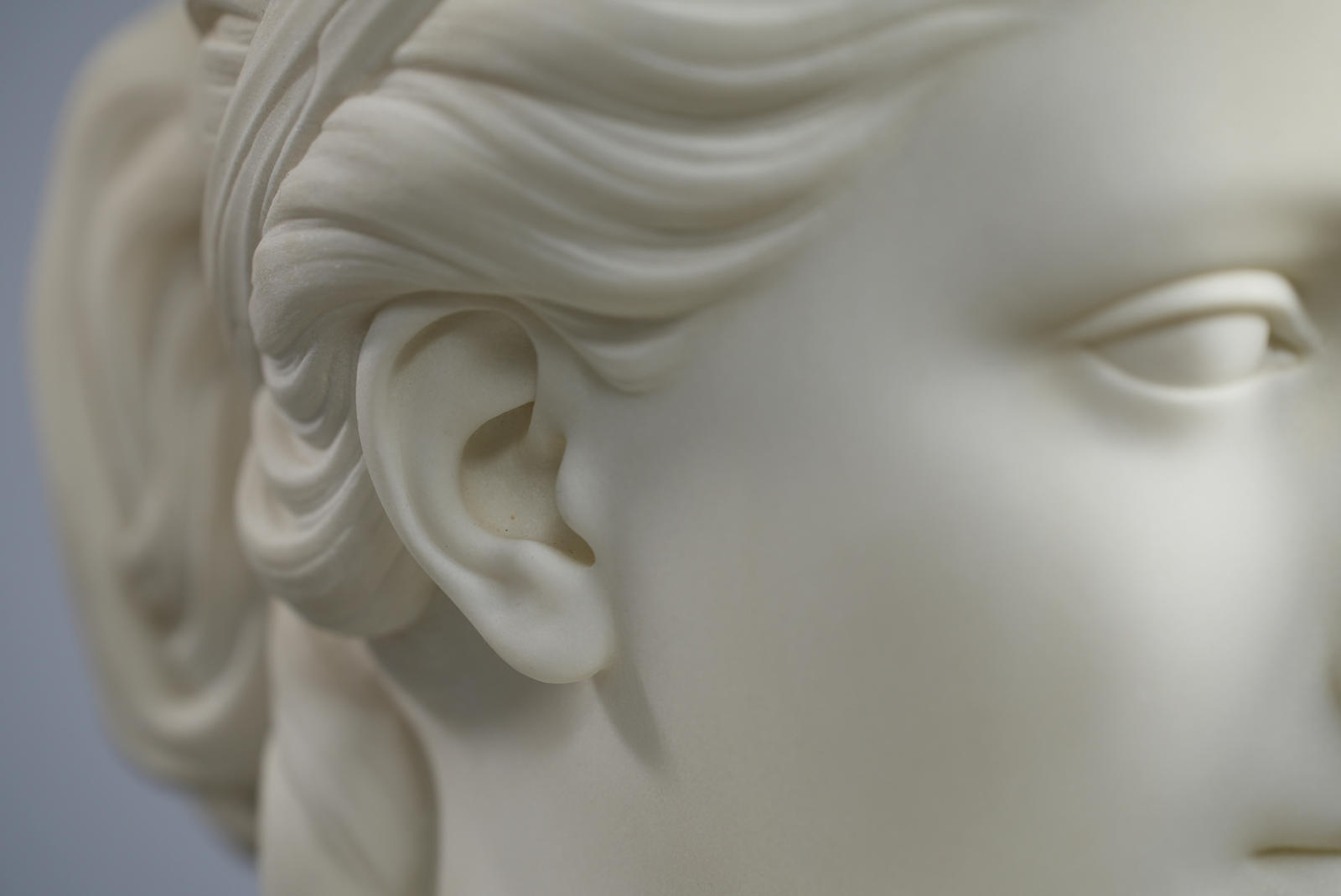












artist
One of Powers' delights after the show opened to the public was to dress as the Devil and slink along amongst the dimly lit figures of the display, inquiring in a sepulchral voice, "Do you think you smell sulphur?" The very popular show gained a bit of respectability through its policy of admitting clergymen without charge, and a lot of notoriety: several of these clergymen were later found at different times lurking in the dark corners of the display room. These worthies, dressed in their black ministerial cloth, would creep out of their dusky hideaways during the show and attempt to lead the "ignorant and terrified" to the "safety" of the church. One can imagine that the result was either instant salvation or instant heart stoppage.
Hiram later studied under Frederick Eckstein, the son of a very talented French sculptor who had immigrated to Cincinnati from Philadelphia. Eckstein taught him to model in wax, clay, and plaster. Hiram's older brother, Benjamin, who was the editor of the local newspaper, tutored him in reading and writing during these years-and made sure he updated his social skills as well. Cincinnati, even then known as the "Queen City" and one of the largest inland ports, was quite a town, considering its relative youth-the area was settled in 1788, and the city was incorporated in 1819-and its relative isolation.
Among the people with whom Powers consorted were such luminaries as John James Audubon, the Marquis de Lafayette, General William Harrison (later the ninth president of "Tippecanoe and Tyler Too" fame), Nicholas Longworth (soon to be the second-richest man in the country), Mrs. Frances Trollope (before she wrote her acerbic discussion of American manners), and Harriet Beecher Stowe. At the age of 27, Hiram felt he was making a good enough living to marry Elizabeth Gibson, the daughter of a boarding housekeeper and a ne'er-do-well alcoholic father, which he did on the first of May, 1832.
About this time, Hiram met Robert Lytle, an Ohio congressman, who took him under his wing. Another friend was the budding lawyer and perennial presidential candidate, Salmon Portland Chase, who, when he later became Secretary of the Treasury, saw to it that Powers was paid in gold for his commissions, rather than in the relatively worthless scrip usually used for government debts during the Civil War.
Powers did busts of Stonewall Jackson, John C. Calhoun, John Marshall, and Martin Van Buren, and traveled to Boston to model busts of Daniel Webster, John Quincy Adams, and Thomas Winthrop. A patron named John Stevens Preston offered to finance a move to Europe, where Hiram could further his career as a sculptor. Hiram returned to Cincinnati from Boston via New York and Woodstock, the last time he was to visit his birthplace, and collected his family for the move to Florence, Italy, where he was to live and work for the rest of his life.
Hiram Powers quickly became a prominent member of the small American colony in Florence, and his studio was soon a stopping point for the great and near-great of Europe, and wealthy and well-known Americans who were "doing the Continent." Many of his visitors sat for a bust. Some of the great and near-great for whom he executed busts were: Joseph Bonaparte (Napoleon's oldest brother), Mary Ray, an American who became the Comtesse de Courval (and guardian of Jeanne d'Arc's suit of armor), Henry Wadsworth
Description
The bust presents the mythical daughter of Zeus, goddess of agriculture, rising out of an acanthus, a symbol of immortality. Allowed by her kidnaper and husband Pluto, ruler of the underworld, to return to the surface only during the spring and summer, the innocent Proserpine brings bloom and joy to the earth. Hiram Power's bust of Proserpine is based on an ancient Roman bust of Clytie. Powers carved five different versions of this bust. The first version shows the figure emerging from an elaborate wicker basket filled with a corsage of spring flowers. The second, the present example, was modeled a year later and features the goddess emerging from a basket filled with acanthus leaves. In the other versions Powers substituted a simple fringe of beads around the base, omitted the molding altogether, and depicted only the goddess’s head and neck.
Proserpine or Persephone, in Greek and Roman religion and mythology is the goddess of fertility and queen of the underworld. She was the daughter of Zeus and Demeter. When she was still a beautiful maiden, Pluto seized her and held her captive in his underworld. Though Demeter eventually persuaded the gods to let her daughter return to her, Persephone was required to remain in the underworld for four months because Pluto had tricked her into eating a pomegranate (food of the dead) there. When Persephone left the earth, the flowers withered and the grain died, but when she returned, life blossomed anew. This story, which symbolizes the annual vegetation cycle, was celebrated in the Eleusinian Mysteries, in which Persephone appeared under the name Kore.












